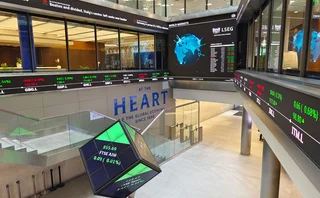
Equity derivatives house of the year: Bank of America
Risk Awards 2025: Bank gains plaudits – and profits – with enhanced product range, including new variants of short-vol structures and equity dispersion

Big in flow, big in prime, big in quant strategies. A long-standing powerhouse in equity derivatives, Bank of America has consistently ticked most of the right boxes – except for one niggling omission: exotics.
After years operating on the fringes, the US dealer is now reaping the rewards of an ambitious multi-year project to build a third-party distribution platform for retail structured notes – the lifeblood of any successful exotics business.
“The structured notes business was the last piece of the puzzle that really moved us ahead,” says Youssef Brahimi, Bank of America’s global head of equity structuring. “It’s been a long journey, but we have made the right strategic choices and have the right business mix in terms of products and strength across regions.”
The hefty investment – in both technology and personnel – follows a top-of-house management overhaul that handed Soofian Zuberi the global equities reins in 2020. Having previously relied on institutional activity and retail distribution through BofA’s own wealth channel, Zuberi convinced new global markets head, Jim Demare, to make structured notes distribution a firm-wide priority.
The investment is bearing fruit. The bank has quadrupled structured notes volume since the project’s inception, issuing over $9 billion in the first three quarters of this year, edging a top-five position in the US
It’s a global effort with the bank eyeing a top-three issuer ranking. “In the Americas we’re well on our way to reaching this target,” says Will Holligan, head of Americas structured sales and co-head of global markets quantitative investment strategies (QIS).
He adds that growth in structured notes volumes in Europe, the Middle East and Africa is “exponential”, while the bank is also investing heavily in the Asia-Pacific region.

As well as jacking up distribution, BofA has broadened its product range by revamping standardised instruments such as variance swaps and dispersion, to cater for changing market environments.
“Our goal is always to challenge the status quo, even on the most commoditised products, and come up with new innovations we can scale to meet client demand,” says Alexandre Isaaz, BofA’s head of equity derivatives sales and structuring for Europe, Middle East and Africa.
“You can’t pretend to anticipate what the future will be, but what you can do is offer a product that should – on average – behave in a smoother manner and be less path-dependent,” he adds.
Clients have been impressed.
“They’re a key player, which wasn’t the case before,” says one hedge fund client. Another buy-side trader calls the journey “one of the fastest and best changes I’ve seen in a long time”. A third praises the bank’s ingenuity: “It’s good to see these light exotics with improved payoffs. It’s made them a top counterparty.”
While the bank doesn’t publicly disclose exotics performance, structured derivatives provided much of the oomph for a 17% surge in equity revenue over the first three quarters of 2024.
Another dimension
With the S&P 500 rising 20% over the first three quarters and the Cboe’s Vix volatility index languishing in the teens for most of the year – outside of an August volatility shock – many traditional risk premia were squeezed. For example, one-year implied correlation for US stocks hit a historic low of 16% in July, while one-month skew on the S&P 500 – the difference between puts and calls – crawled to its first percentile.
Common-or-garden risk premia required a makeover to give them new appeal for prospective buyers.
An example is ‘VarSelect’ – a fresh take on the popular variance swap, a staple of the over-the-counter volatility landscape since the 1990s. Traditional variance swaps reflect close-to-close realised volatility and are commonly used to take short volatility bets. These trades deliver a steady income stream but suffer asymmetric tail losses in high stress scenarios such as the global financial crisis or 2020 Covid pandemic.
Attempts to reduce this risk have largely focused on the strategy, yet Bank of America chose to re-engineer the instrument itself.
VarSelect incorporates a dynamic observation schedule. This reduces the observation frequency when underlying spot moves are negative. The new design cuts short volatility exposure in times of turbulence, mitigating the daily drawdowns associated with traditional variance swap selling.
“What we’re doing on VarSelect is not completely changing the nature of the product. In terms of risk, it’s cutting a bit of the left tail historically, but it stays similar in terms of modelling and the overall mindset of the trade,” says Raphael Cyna, BofA’s global head of payoff structuring.

Cyna adds that the product still looks and feels much like a standard variance swap, which means it can be marketed to a wide client base. “It’s a generic product that we’re slightly tweaking and that’s what makes it scalable,” he says.
In backtests, the bank says a short volatility strategy created with VarSelect outperforms standard iterations by more than 20 points in extreme events. In normal conditions, performance is roughly in line.
“The best way of seeing VarSelect is a diversifier for your short volatility sleeve. It’s a way to not have all your eggs in the same basket in one payoff and one implementation,” says Cyna.
Some large buy-side clients have adopted the instruments as part of their systematic vol selling programmes.
The bank also modified its volatility target structure, Fast Convergence. Launched in 2018. the product is designed to be responsive to sudden shifts in volatility. The latest iteration, called Hourly Compass, adds a market-direction component to refine the approach.
Volatility target strategies adjust leverage in response to changes in vol. Typically, the product trims leverage when vol rises – usually coinciding with falling spot levels. However, in scenarios where vol and spot move up in tandem, these strategies may benefit by not deleveraging. Hourly Compass considers both volatility and spot moves before rebalancing. Backtests show the enhancement can add more than 100 basis points of annualised outperformance versus the standard approach.
The mechanism was adopted by a large insurance carrier for an S&P 500-tracking fixed indexed annuity in late 2023.
Isaaz believes these multi-dimensional components will be increasingly important in a world where market cycles turn more rapidly.
“The historical relationships seen in the past, whether it’s equities and bonds or volatility dynamics, tend to fluctuate more and cycles tend to be shorter. You need a panel of products that can adapt to these different environments,” he says.
Dispersion sweetener
Some innovations were tailored for more immediate challenges.
One of the most high-profile exotic trades – equity dispersion – blew hot and cold in 2024. The trade sees investors couple a short index vol position with long single stock vol as a bet that single stocks will diverge from the index. Despite strong demand, historic lows in correlation inflated the cost of entry and squeezed returns.
Dispersion is often structured in such a way as to restrict the payoff to periods when constituent stocks trade within a narrow range – an approach that aligns with barriers embedded in the structured notes these trades typically hedge.
Yet buyers faced issues when large tech stocks such as Meta and Nvidia surged beyond their upper bounds during earnings rounds. While these events created significant realised dispersion, holders of the traditional corridor structure missed out on the opportunity to monetise these moves as stocks had breached their barrier.

BofA introduced a sweetener that offers dispersion holders the full move up to the barrier, even if it is breached. Known as ‘up-to-barrier’, this upgraded version began trading during the third quarter.
“We know the earnings on those [large tech] names have been the main driver of the profit and loss in dispersion trades. When we went back to the drawing board to come up with an innovation on this product, this was the first thing we were looking to optimise – how to capture the earnings move,” says Cyna.
One hedge fund user calls it “a very good innovation” that set the bank apart from competitors.
While the upgrade comes at a higher implied spread to enter, buyers benefit from a realised spread that, at worst, performs in line with standard structures and outperforms when barriers are breached.
Importantly, it’s a small enough twist that it doesn’t substantially alter operational or risk management considerations for the bank or its clients.
“We try to stay on the simpler side to keep it scalable and make the innovation all-weather,” says Cyna.
Defences up
The perennial challenge for short-volatility structurers is how to buy back some of the explosive left tail without dampening returns. BofA addressed this problem with a new twist on the defensive short-vol strategy.
The Defensive Vol Selling (DVS) index sidesteps the need to purchase costly downside tail protection, instead introducing a modified weighting scheme to the variance replication that transfers risk to the upside.
The benefits were evident after August 5, when the Vix spiked 180% in pre-market trading. The drawdown for DVS was less than half that of a standard short variance strategy on a vol-adjusted basis, the bank reports.
“With defensive vol, it’s about having something that’s able to earn carry without being additive to the left tail,” says Ben Barr, head of QIS structuring for Europe, the Middle East and Africa. “August is a great case study of the power of it. With our DVS index you’re transferring that risk in such a way that expected losses are generally at times when the broader portfolio is doing very well, rather than being risk-additive.”

The strategy makes use of liquidity in zero-day-to-expiry options on the S&P 500 as well as same-day options on the Euro Stoxx 50, which are traded at Eurex.
The product has proved a hit with QIS clients, with sales of more than $2 billion notional.
Elsewhere in the QIS lab, the bank teamed up with Newton Investment Management to create a new all-weather hedging strategy. Built from a collection of indexes off the QIS shelf, the strategy provides protection across a range of scenarios: sharp selloffs, sustained drawdowns and intraday selloffs.
BofA supplied the building blocks in the form of the indexes, while Newton manages the weightings. The collaboration arose from a client with limited derivatives experience seeking additional comfort for selecting and managing QIS strategies, though Barr sees wider applicability.
“It’s a ‘best of both worlds’ solution. You get the IP and the execution capabilities of BofA, plus all of the typical benefits of QIS, but you also get the asset manager’s selection and allocation expertise combined with ongoing monitoring and oversight,” says Isaaz.
“Innovation doesn’t always mean increasing complexity – sometimes it can just mean thinking outside the box,” says Barr.
Basket case
For a bank with core strengths in QIS and delta one, custom baskets – the intersection of these two businesses – had long been an overlooked opportunity. But a strong geopolitical motif in 2024, with more than half of the world’s population heading to the polls, made the product a priority.
“It was an important catalyst, and if you see what’s happening in the factor space, with momentum and size factors getting to very stretched levels, you had lots of sector rotation. Custom baskets really play into this theme,” says Brahimi.
The bank added more than 50 new clients to its sales roster and doubled revenues in baskets.
Popular themes included artificial intelligence baskets, which screen single names through the bank’s ‘AI factor’ lens, and winners-versus-losers baskets tied to US and French elections.
“In a world where there is more dispersion, there’s a lot of alpha to be generated via active management versus passive, so it makes sense to have a robust custom basket business to service clients and help them navigate this new environment,” says Brahimi.
Only users who have a paid subscription or are part of a corporate subscription are able to print or copy content.
To access these options, along with all other subscription benefits, please contact info@risk.net or view our subscription options here: http://subscriptions.risk.net/subscribe
You are currently unable to print this content. Please contact info@risk.net to find out more.
You are currently unable to copy this content. Please contact info@risk.net to find out more.
Copyright Infopro Digital Limited. All rights reserved.
As outlined in our terms and conditions, https://www.infopro-digital.com/terms-and-conditions/subscriptions/ (point 2.4), printing is limited to a single copy.
If you would like to purchase additional rights please email info@risk.net
Copyright Infopro Digital Limited. All rights reserved.
You may share this content using our article tools. As outlined in our terms and conditions, https://www.infopro-digital.com/terms-and-conditions/subscriptions/ (clause 2.4), an Authorised User may only make one copy of the materials for their own personal use. You must also comply with the restrictions in clause 2.5.
If you would like to purchase additional rights please email info@risk.net
More on Awards
Clearing house of the year: LCH
Risk Awards 2025: LCH outshines rivals in its commitment to innovation and co-operation with clearing members
Best use of machine learning/AI: CompatibL
CompatibL’s groundbreaking use of LLMs for automated trade entry earned the Best use of machine learning/AI award at the 2025 Risk Markets Technology Awards, redefining speed and reliability in what-if analytics
Markets Technology Awards 2025 winners’ review
Vendors jockeying for position in this year’s MTAs, as banks and regulators take aim at counterparty blind spots
Law firm of the year: Linklaters
Risk Awards 2025: Law firm’s work helped buttress markets for credit derivatives, clearing and digital assets
Derivatives house of the year: UBS
Risk Awards 2025: Mega-merger expected to add $1 billion to markets revenues, via 30 integration projects
Interest rate derivatives house of the year: JP Morgan
Risk Awards 2025: Steepener hedges and Spire novations helped clients navigate shifting rates regime
Currency derivatives house of the year: UBS
Risk Awards 2025: Access to wealth management client base helped Swiss bank to recycle volatility and provide accurate pricing for a range of FX structures
Inflation derivatives house of the year: Natixis
Risk Awards 2025: French bank’s hedge fund push boosts its flow standing and creates repack risk offsets







